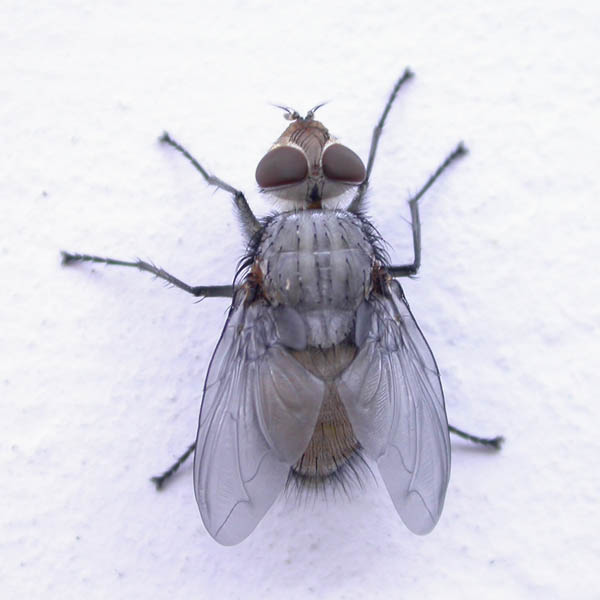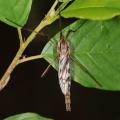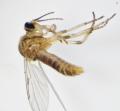Diptera.info :: Identification queries :: Diptera (adults)
Who is here? 1 guest(s)
|
Calliphora sp, Calliphoridae. Hungary
|
|
| Xespok |
Posted on 26-08-2006 20:44
|
|
Member Location: Debrecen, Hungary Posts: 5551 Joined: 02.03.05 |
This was a very large and interesting fly from April. I think it is a Calliphorid fly, but I am not sure at all. Any idea what this is? Is this a common species just after emerging? Some other images are on my web site. Xespok attached the following image:  [63.13Kb] Edited by Xespok on 11-09-2006 20:47 |
| Nikita Vikhrev |
Posted on 26-08-2006 21:08
|
|
Member Location: Moscow, Russia Posts: 9423 Joined: 24.05.05 |
Hi Xespok. I think it is Tachinidae just after emerging. Nikita Nikita Vikhrev - Zool Museum of Moscow University |
|
|
|
| Xespok |
Posted on 06-09-2006 21:04
|
|
Member Location: Debrecen, Hungary Posts: 5551 Joined: 02.03.05 |
So can I put this down as a Tachinid fly? M vein has a strong kink, does this help? |
| Tony Irwin |
Posted on 06-09-2006 21:31
|
|
Member Location: Norwich, England Posts: 7279 Joined: 19.11.04 |
In this condition, before the cuticle has coloured up, it's difficult to say, but I note that the antennae look like they are plumose. Now, if I have been listening correctly to Theo's teachings, there are very few Tachinidae with plumose arista, and I don't think any of them are likely to be this shape, so I'd say Calliphoridae. 
Tony ---------- Tony Irwin |
|
|
|
| Nikita Vikhrev |
Posted on 07-09-2006 08:21
|
|
Member Location: Moscow, Russia Posts: 9423 Joined: 24.05.05 |
My reason was that plumose arista or not is badly visible, but as Xespok has wrote vein M curved too strong for Calliphoridae. So, I think we need Theo's opinion. If Theo will exclude Tachinidae, than I think that in april, with such head shape and with such M it has to be Cynomyia mortuorum. Nikita Nikita Vikhrev - Zool Museum of Moscow University |
|
|
|
| ChrisR |
Posted on 07-09-2006 10:05
|
|
Super Administrator Location: Reading, England Posts: 7703 Joined: 12.07.04 |
I am pretty sure it isn't a tachinid ... there is the bend in vein-M but with such strongly plumose arista (apparently) and soft hairs, not thick bristles ... I'd go for Callaphoridae perhaps ... hard to say for sure though  |
| Tony Irwin |
Posted on 07-09-2006 10:46
|
|
Member Location: Norwich, England Posts: 7279 Joined: 19.11.04 |
The very deep bend in vein M is misleading because the wing has not expanded fully. When it has expanded more, the bend in vein M will not be so acute, and it will be much more like a normal calliphorid. The head shape is also misleading because the ptilinum has not yet contracted fully, so the frons appears longer than it will be. There's more than one pair of presutural acrostichals, so I don't think it's Cynomyia. I haven't checked fully, but my guess is Lucilia or Calliphora - the chaetotaxy should be able to get it to genus, but I'm pushed for time this morning! 
Tony ---------- Tony Irwin |
|
|
|
| Nikita Vikhrev |
Posted on 07-09-2006 13:30
|
|
Member Location: Moscow, Russia Posts: 9423 Joined: 24.05.05 |
Tony and Chris, I have to admit that your reasons are much more reasonable than mine. Nikita
Nikita Vikhrev - Zool Museum of Moscow University |
|
|
|
| Xespok |
Posted on 07-09-2006 15:40
|
|
Member Location: Debrecen, Hungary Posts: 5551 Joined: 02.03.05 |
This fly was a very large one, aorund 14-16mm, much larger than Lucilia, at least in the size range of Calliphora. So I'd go for Calliphora or Cynomyia. Actually I found this fly on the wall of the Institute of Pathology and Forensic Medicine. So there is a realistic chance that it developed in a human. |
| Zeegers |
Posted on 07-09-2006 16:52
|
|
Member Location: Soest, NL Posts: 18917 Joined: 21.07.04 |
Can't help you out without a head profile, but agree with Tony, chances that this is a Tachinid are quite small indeed. And agree with his arguments Theo |
|
|
|
| Tony Irwin |
Posted on 07-09-2006 18:48
|
|
Member Location: Norwich, England Posts: 7279 Joined: 19.11.04 |
Thanks for the extra information, Xespok. From what you tell us, I'd have to say Calliphora. Cynomyia mortuorum (the only European species) has a single pair of presutural acrostichal bristles (as a rule), and also has an anterior preapical bristle on the mid femur, so it clearly isn't that. No other European calliphorids reach such a size.
Tony ---------- Tony Irwin |
|
|
|
| Jump to Forum: |













